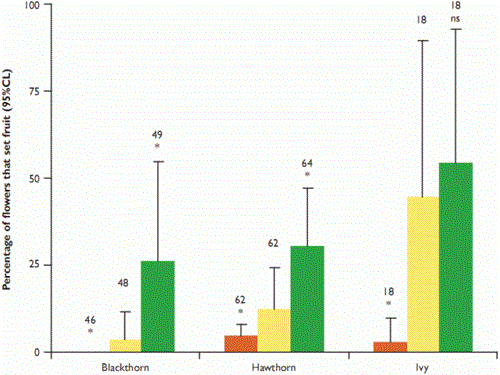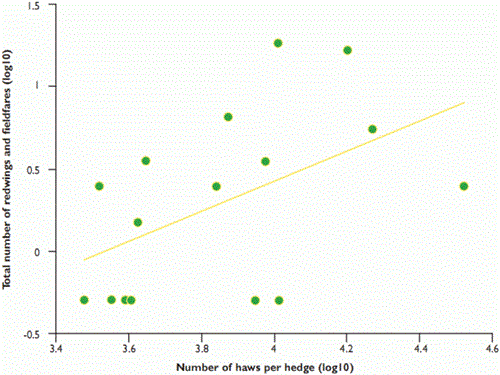Many pollinating insects have declined in abundance in recent decades. This has been well publicised for bumblebees, and more recently honeybees. Such declines could have ecological effects on other wildlife such as frugivorous (fruit-eating) birds if reduced pollinator abundance results in fewer hedgerow fruits. This project, carried out in collaboration with Rothamsted Research and Stirling University, investigated the role of pollinating insects in determining fruit set in five common hedgerow shrubs – blackthorn, hawthorn, ivy, bramble and dog rose.
The research was carried out at Loddington, and at Rothamsted and three additional farms in Hertfordshire between 2004 and 2008. As well as transects along hedges to record abundance of insects, and (in winter) fruit-eating birds, the main focus of the research was to test each plant’s requirement for insect pollination by excluding insects from flowers using fine mesh bags on wire frames, and examining the proportion of flowers that set fruit (see Figure 1). At the same time, we left some flowers unbagged to be pollinated by insects, and we pollinated some by hand to increase the chances of pollination. If hand-pollinated flowers had a higher fruit set than those that were left for insects, it would indicate that local insect abundance was insufficient for adequate pollination. We counted buds in each treatment before flowering, and later counted the mature fruit.
Figure 1: Average proportion of hedgerow flowers setting mature fruit under different pollination treatments on hedges at three farms in Hertfordshire in 2007

Values above columns are number of groups of buds per treatment. Significance values of treatment comparisons with ‘open pollination’ are denoted * = P<0.001, ns = no significant difference.
 Bramble and dog rose produced fruit even when insects were excluded, indicating little need for insect pollination. For blackthorn, no mature fruits developed when insects were excluded, and only 4% of flowers formed mature fruit when left open for insects. Hand-pollination resulted in the highest fruit production of all (26%). These results suggest that blackthorn fruit production is strongly limited by pollinator abundance.
Bramble and dog rose produced fruit even when insects were excluded, indicating little need for insect pollination. For blackthorn, no mature fruits developed when insects were excluded, and only 4% of flowers formed mature fruit when left open for insects. Hand-pollination resulted in the highest fruit production of all (26%). These results suggest that blackthorn fruit production is strongly limited by pollinator abundance.
We obtained similar results for hawthorn. Hand-pollinated flowers set more fruit (31%) than those left open (12%), which in turn set more fruit than bagged flowers (5%). So for hawthorn as well, the abundance of pollinating insects limited fruit set. For ivy, hand pollination did not increase fruit set (56%) over that of flowers left open (45%), but fruit set of bagged flowers was significantly lower than in the other treatments (3%). This suggests that, although insects are essential for ivy berry production, natural insect abundance is not limiting. Observations of insect activity and counts of pollen grains carried by insects suggest that different insect groups are important for blackthorn, hawthorn and ivy pollination. For the early-flowering blackthorn, bumblebees appear to be the primary pollinators, whereas for hawthorn, solitary bees are more important, and for ivy, wasps are the main pollinators. The flowering periods of these plants coincide well with the major flight periods of their pollinators, suggesting that these are mutually beneficial relationships that have evolved over time.
Figure 2: Abundance of redwings and fieldfares in relation to number (mean) of haws in 16 hedges over the winter

ŷ = 3.23+0.914x, r2adj = 0.20, P = 0.047)
In the winters of 2005/2006 and 2006/2007, we found a positive relationship between the abundance of thrushes (blackbird, song thrush and redwing) seen in 14 hedges (of similar height and width) during fortnightly surveys along 100-metre transects and the abundance of sloes, and on 16 hawthorn hedges we found a positive relationship between the abundance of the migratory thrushes, redwing and fieldfare and haw abundance (see Figure 2). These findings confirm the importance of hedgerow berries for wintering birds. These and other species are likely to benefit if management on farmland accommodates the pollinators of hedgerow plants identified by this project. Such management might include the provision of alternative foraging sites for insects (eg. appropriately designed pollen and nectar mixtures) and suitable nesting habitat for both breeding and over-wintering insects.